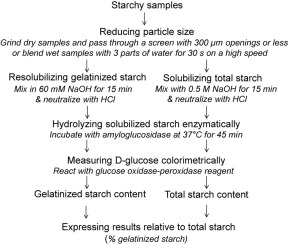当前位置:
X-MOL 学术
›
Food Hydrocoll.
›
论文详情
Our official English website, www.x-mol.net, welcomes your feedback! (Note: you will need to create a separate account there.)
Enzymatic determination of total starch and degree of starch gelatinization in various products
Food Hydrocolloids ( IF 10.7 ) Pub Date : 2020-06-01 , DOI: 10.1016/j.foodhyd.2019.105639 Keshun Liu , Qian Liu
Food Hydrocolloids ( IF 10.7 ) Pub Date : 2020-06-01 , DOI: 10.1016/j.foodhyd.2019.105639 Keshun Liu , Qian Liu

|
Abstract The degree of starch gelatinization (DSG) affects not only structural, physicochemical and organoleptic properties but also susceptibility to enzymatic digestion and thus nutritional values of starchy products. DSG determination has been conducted in many laboratories, entailing measurements of both gelatinized and total starch. However, current enzymatic methods are complex and inaccurate. For addressing these problems, this study was conducted. Results show that gelatinized and native starch solubilized maximally at different NaOH concentrations and that proper sample pretreatments to solubilize starch were important for obtaining accurate results. For gelatinized starch assay, optimal pretreatments entailed mixing in 40–80 mM NaOH solution at 150 rpm for 15–70 min. For total starch measurement, mixing samples in 0.5 M NaOH for as short as 5 min or autoclaving for 60 min was optimal but boiling for 60 min was not. Consequently, a new method was proposed to measure DSG, consisting of differential alkaline pretreatments of samples for determining gelatinized starch and total starch, respectively, hydrolysis of solubilized starch by amyloglucosidase, and colorimetric measurement of d -glucose released by glucose oxidase-peroxidase. Furthermore, DSG calculation was significantly simplified by using absorbance ratio of gelatinized starch over total starch and by omitting a correction factor for limited hydrolysis of native starch. This calculation eliminates the need for assessing absolute contents of gelatinized and total starch and determining the correction factor. The new method was validated and compared with a prior method. It enabled simple and accurate analysis of gelatinized starch, total starch, and DSG in various products in situ.
中文翻译:

各种产品中总淀粉和淀粉糊化度的酶法测定
摘要 淀粉糊化程度 (DSG) 不仅影响结构、物理化学和感官特性,而且影响酶消化的敏感性,从而影响淀粉产品的营养价值。许多实验室都进行了 DSG 测定,需要测量糊化淀粉和总淀粉。然而,目前的酶促方法复杂且不准确。为了解决这些问题,进行了这项研究。结果表明,糊化淀粉和天然淀粉在不同 NaOH 浓度下的增溶作用最大,适当的样品预处理以增溶淀粉对于获得准确的结果很重要。对于糊化淀粉测定,最佳预处理需要在 40-80 mM NaOH 溶液中以 150 rpm 的速度混合 15-70 分钟。对于总淀粉测量,在 0 中混合样品。5 M NaOH 短至 5 分钟或高压灭菌 60 分钟是最佳的,但沸腾 60 分钟不是。因此,提出了一种测量 DSG 的新方法,包括分别测定糊化淀粉和总淀粉的样品的差异碱性预处理,淀粉葡萄糖苷酶对溶解淀粉的水解,以及葡萄糖氧化酶 - 过氧化物酶释放的 d-葡萄糖的比色测量。此外,通过使用糊化淀粉与总淀粉的吸光度比并省略天然淀粉有限水解的校正因子,显着简化了 DSG 计算。该计算无需评估糊化淀粉和总淀粉的绝对含量并确定校正因子。新方法经过验证并与先前方法进行比较。
更新日期:2020-06-01
中文翻译:

各种产品中总淀粉和淀粉糊化度的酶法测定
摘要 淀粉糊化程度 (DSG) 不仅影响结构、物理化学和感官特性,而且影响酶消化的敏感性,从而影响淀粉产品的营养价值。许多实验室都进行了 DSG 测定,需要测量糊化淀粉和总淀粉。然而,目前的酶促方法复杂且不准确。为了解决这些问题,进行了这项研究。结果表明,糊化淀粉和天然淀粉在不同 NaOH 浓度下的增溶作用最大,适当的样品预处理以增溶淀粉对于获得准确的结果很重要。对于糊化淀粉测定,最佳预处理需要在 40-80 mM NaOH 溶液中以 150 rpm 的速度混合 15-70 分钟。对于总淀粉测量,在 0 中混合样品。5 M NaOH 短至 5 分钟或高压灭菌 60 分钟是最佳的,但沸腾 60 分钟不是。因此,提出了一种测量 DSG 的新方法,包括分别测定糊化淀粉和总淀粉的样品的差异碱性预处理,淀粉葡萄糖苷酶对溶解淀粉的水解,以及葡萄糖氧化酶 - 过氧化物酶释放的 d-葡萄糖的比色测量。此外,通过使用糊化淀粉与总淀粉的吸光度比并省略天然淀粉有限水解的校正因子,显着简化了 DSG 计算。该计算无需评估糊化淀粉和总淀粉的绝对含量并确定校正因子。新方法经过验证并与先前方法进行比较。


























 京公网安备 11010802027423号
京公网安备 11010802027423号